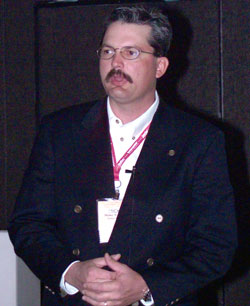7:30 am - 10:45 am • Yuma 21 Room
RM 101: Wildlife for Fun and Profit
Dr. Dale Rollins, Texas A&M Univ.; Kelly Flynn, Hidden Hollow Hideaway, MT; Paul Genho, Moderator, & Butch Thompson, King Ranch, TX
Managing wildlife for fun and profit
 |
| Mickey Hellickson, a biologist at the legendary King Ranch in Kingsville, Texas, said stewardship and wildlife management play important roles in the ranch’s economic goals. |
Ranchers hoping to develop an alternative income can take advantage of resources already on the ranch, three wildlife experts told participants of the annual Cattlemen’s College® Wednesday, Jan. 28, prior to the 2004 Cattle Industry Annual Convention.
Dale Rollins, Texas A&M Extension wildlife specialist, told the crowd gathered at the Phoenix Civic Plaza, Phoenix, Ariz., that with proper care and management ranchers can earn money by adapting their land-use practices to promote the growth of wildlife — thus, encouraging revenue from nature enthusiasts and hunting patrons. In fact, Rollins said landowners utilizing hunting leases can often earn more from their land, on a per acre basis, than those solely raising cattle.
“The basis of land value today is governed by the demand for recreation,” he said, referring to a 1999 study reporting that the average quail hunter spent an average $10,354 during the year, at an average 48 birds per hunter. That’s approximately $512 per pound (lb.).
With such earning potential, nature tourism and wildlife management is a trend on the rise — a trend ranchers like Kelly Flynn, Townsend, Mont., have recognized as a significant income source. Flynn offers guest ranch vacations and deer and elk hunting trips, as well as horseback riding, cattle work, wildlife watches and scenic tours on his Hidden Hollow Hideaway ranch. He said his father first developed the idea in the 1960s. Now wildlife management and paid hunting trips account for more than 50% of Flynn’s gross income.
“We decided we needed to do something different on our ranch,” he said of the average-sized operation spanning both public and private lands. “We had rising costs, and my parents said, ‘How are we going to have enough income to make it?’”
Flynn said creativity and people skills are essential for landowners hoping to develop wildlife tourism. Any rancher in any geographic location can promote the unique aspects of his or her ranch while practicing good stewardship, he said. “We have to steward the land so our place will be better for what we have done.”
Mickey Hellickson, a biologist at the legendary King Ranch in Kingsville, Texas, said stewardship and wildlife management play important roles in the ranch’s economic goals. “The annual income derived from wildlife often equals or exceeds income derived from cattle,” he said, adding profit depends on weather and market conditions.
The native and introduced grass species covering the 825,000 acres of the King Ranch system are managed intensively to promote both wildlife and cattle. Hellickson said the ranch uses a variety of management techniques, including a diverse grazing system, brush management and hunting quotas. The ranch also works with universities on research projects, and it promotes youth programs.
“Brush management is a process, not an event,” he said. “You have to follow up.”
Although there are many benefits to incorporating wildlife development and hunting into a ranching system, the presenters said there is give and take.
“You can’t simultaneously maximize profitability for cattle and for wildlife management,” Rollins said. “There’s always going to be tradeoffs.”
Hellickson agreed. “Although a positive economic return is gained from both the cattle and wildlife at King Ranch, neither generates sufficient income to yield an acceptable return on investment. Both cattle and wildlife managers must cooperate and compromise.”
Hellickson said the ranch stocks cattle — at one animal unit (AU) per 20-30 acres — based on grass, not on total acres. Flynn said ranchers should consider food requirements of wildlife, as well as possible legal issues, including permits and liability concerns.
“There’s a delicate balance,” he said. “You have to wear a lot of different hats, and you have to stand out from the crowd.”
— by Crystal Albers
Click here for a paper titled, Wildlife manager, or miner?
Click here to download Diversifying Income from Wildlife Enterprises:A test!
Click here for a paper titled, Golden Spreads

